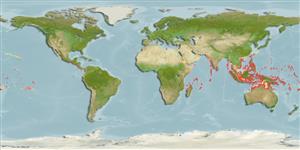Common names from other countries
>
Anguilliformes (Eels and morays) >
Muraenidae (Moray eels) > Muraeninae
Etymology: Enchelycore: Greek, enchelys, = eel + Greek, kore = pupil (Ref. 45335).
More on author: Bleeker.
Environment: milieu / climate zone / depth range / distribution range
Ecologia
marino associati a barriera corallina; distribuzione batimetrica 5 - 35 m (Ref. 90102). Tropical; 30°N - 18°S
Indo-Pacific: from the Red Sea, Mauritius, and Chagos Archipelago, to French Polynesia; absent from Hawaiian Islands.
Size / Peso / Age
Maturity: Lm ? range ? - ? cm
Max length : 120 cm TL maschio/sesso non determinato; (Ref. 559)
Spine dorsali (totale) : 0; Raggi dorsali molli (totale) : 0; Spine anali: 0; Raggi anali molli: 0; Vertebre: 137 - 142. The longest canines of the lower jaw are confined to the anterior third of the toothed area. Coloration is a uniform tan with a conspicuous white margin on the fins.
Occurs in lagoon and seaward reefs (Ref. 9710). Solitary in crevices, usually seen at night (Ref 90102).
Life cycle and mating behavior
Maturities | Riproduzione | Spawnings | Egg(s) | Fecundities | Larve
Smith, D.G., 2012. A checklist of the moray eels of the world (Teleostei: Anguilliformes: Muraenidae). Zootaxa 3474:1-64. (Ref. 92337)
IUCN Red List Status (Ref. 130435)
CITES (Ref. 128078)
Not Evaluated
Threat to humans
Harmless
Human uses
Pesca: di potenziale interesse
Strumenti
Special reports
Download XML
Fonti Internet
Estimates based on models
Preferred temperature (Ref.
115969): 26.4 - 29, mean 28 (based on 372 cells).
Phylogenetic diversity index (Ref.
82804): PD
50 = 0.5002 [Uniqueness, from 0.5 = low to 2.0 = high].
Bayesian length-weight: a=0.00042 (0.00024 - 0.00071), b=3.25 (3.11 - 3.39), in cm Total Length, based on LWR estimates for this species & (Sub)family-body (Ref.
93245).
Trophic level (Ref.
69278): 4.6 ±0.8 se; based on size and trophs of closest relatives
Resilienza (Ref.
120179): Molto basso, tempo minimo di raddoppiamento della popolazione più di 14 anni (Preliminary K or Fecundity.).
Fishing Vulnerability (Ref.
59153): High to very high vulnerability (72 of 100).
